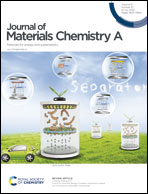A rational configuration for ultralong lifespan all-solid-state organic sodium-metal batteries†
Abstract
Organic sodium-metal batteries (OSMBs) have become one of the most promising contestants for use in energy storage systems. However, the practical applications of OSMBs are limited because the organic materials always suffer from dissolution in traditional liquid electrolytes. Using succinonitrile-based plastic crystal electrolytes (SN-based PCEs) has been proven to solve the dissolution issue. Herein, 5 mol% NaClO4/SN PCE was first selected to match the high theoretical specific capacity cathode pillar[5]quinone (P5Q) to assemble sodium-metal batteries. This electrolyte synergistically achieves high ion conduction and high decomposition voltage. In addition, the interfacial compatibility between the electrolyte and Na anode was improved by pretreatment. Benefitting from the rational configuration, the OSMB demonstrates a specific discharge capacity of 251 mA h g−1 after 1000 cycles at 0.2C, corresponding to an excellent capacity retention rate of 61%. Even at a high current density of 1C, the capacity still remains at 210 mA h g−1. This work has realized the ultralong lifespan of OSMB, which has important practical significance.



 Please wait while we load your content...
Please wait while we load your content...